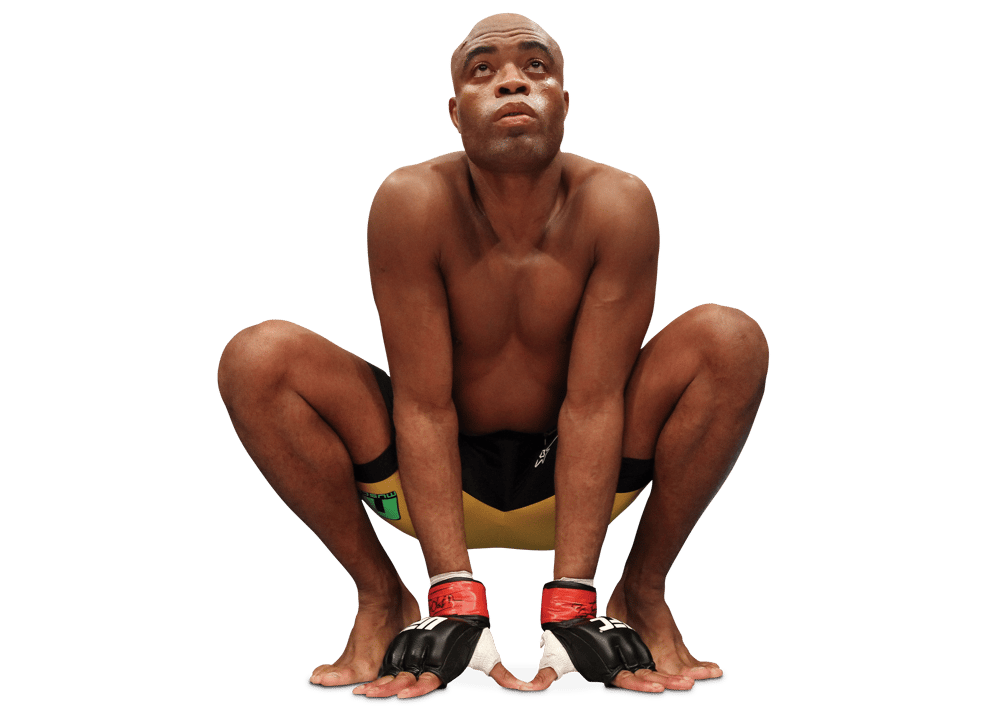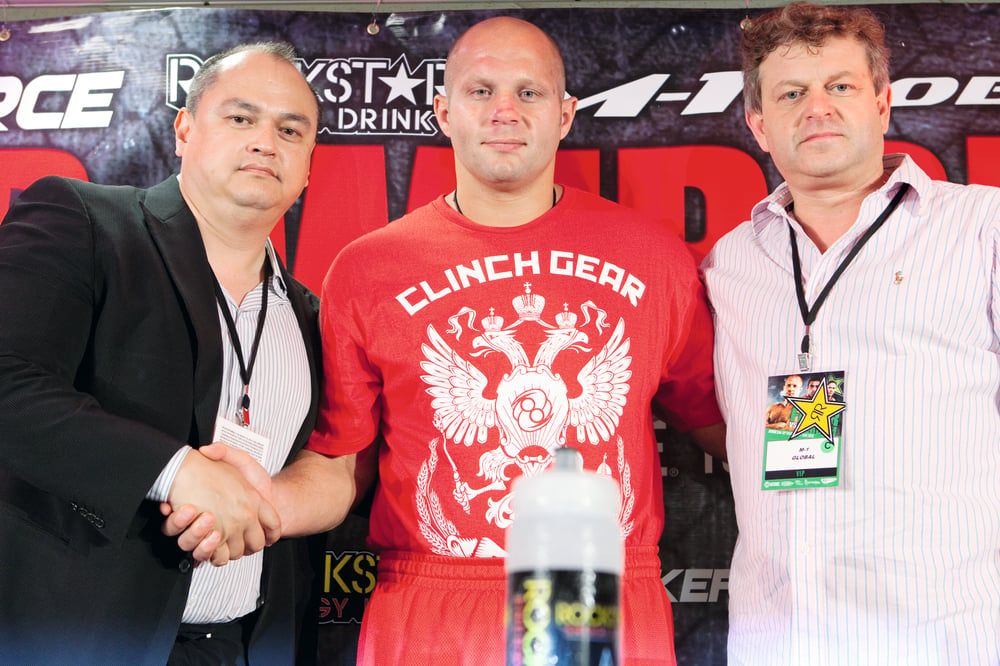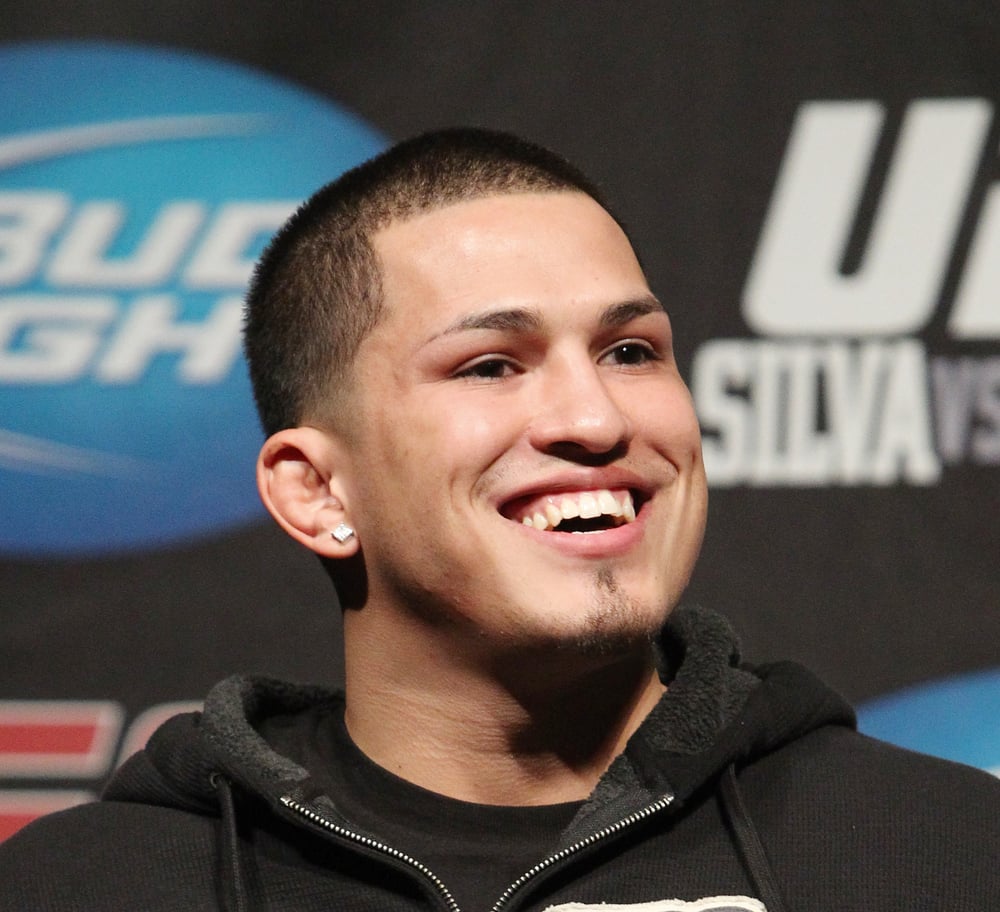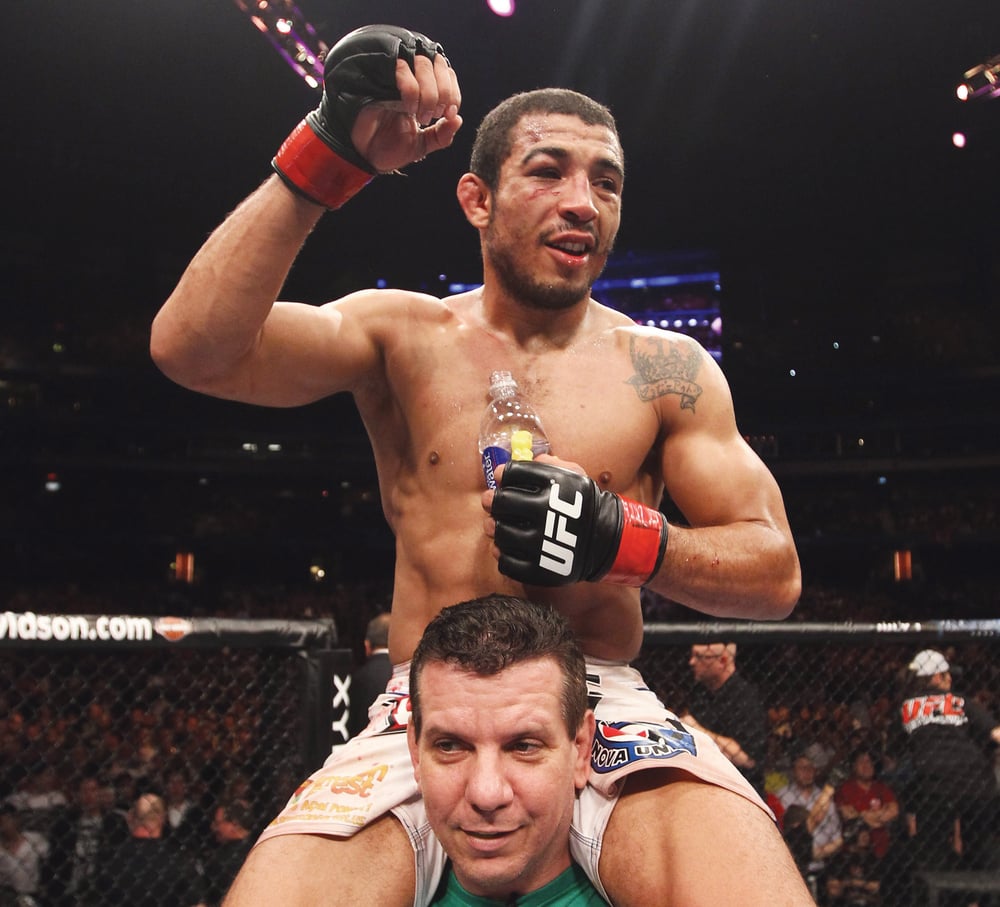
Issue 118
August 2014
Think you know who the true world champions of MMA are? Think again. To be the man you have to beat the man. And some leading contenders have more right to call themselves champ than the title holders. FO investigates...
Boxing can do one thing MMA can’t. It can crown undisputed champions. Fighters who hold titles from every top organization. Pound-for-pound king Floyd Mayweather has all the marbles, just like Roy Jones Jr used to. By unifying the belts they became unarguably the best in the world.
MMA is fractured. Bellator and the UFC won’t have all their title-holders square off on one mega fight card. And champions who were once thought legitimate threats to their opposite numbers in the UFC, like those in Strikeforce, dropped their belts to join the world’s strongest promotion. Others had their gold dive in value when their home promotions bit the dust.

So, there’ll never be an undisputed champion in mixed martial arts, right? Not exactly.
There’s something called lineal championships. Basically, it’s a way of thinking where a belt isn’t attached to a promotion, it’s attached to a person. You have to beat the man to become the man.
You start with a title’s first owner and trace their career until they lose at that weight, dropping the belt. You can track all the true UFC champions in every division, and find who are the lineal champions of Pride, Strikeforce, Bellator and any company before or since.
Doing exactly that, we discovered the true undisputed kings of mixed martial arts, and in the following pages you will too. Charting over 40 belts from the UFC, Pride, Strikeforce, World Extreme Cagefighting (WEC), EliteXC, International Fight League (IFL) and Bellator. We found several surprises, and more than a few shocks (spoiler: Chael Sonnen has as many UFC title reigns as Anderson Silva).
Some ‘title trees’ come to a neat conclusion. Others do not – the UFC welterweight title among them. We won’t tell you now where the welterweight lineage leads, but let’s say the return of a certain French Canadian would benefit more than just the UFC’s coffers.
So, which fighters hold today’s Pride titles, how many people never actually won a real UFC belt, and who are MMA’s real undisputed champions?

THE RULES
To make sure our resulting lineal champions are as correct as possible, we’ve set rules. Like, Ultimate Fighter exhibition bouts don’t count, the first champion is the first person with the belt (not always a tournament winner) and a title cannot be contested outside its weight class.
If a middleweight champion loses at light heavyweight, they keep their belt – like BJ Penn did with the UFC 155lb title when he lost to Georges St Pierre at 170lb. Although, we did find a few rather interesting caveats to that: if we’re tracking a belt owned by a promotion and the company decides it can be contested at an altered weight, that organization’s lineal belt is too. Might seem unimportant, now but trust us, it won’t be.
In a similar vein, although it’s common for a title fight that neither champ nor challenger can be an ounce over the weight limit, we’ve permitted a 1lb discrepancy. That’s because, some ruling bodies will allow that in a championship fight, and it’s the norm for any other bout.
As a lot of these lineal title fights aren’t real-world title bouts they go ahead with competitors at 205.8lb, for example. Considering they aren’t actually over by more than 1lb, they have the right to win the lineal belt in our book. Again, it’s a minor point that becomes very important.
On the flip side of that, a championship can be contested under its maximum weight limit provided it doesn’t encroach on a lower division. So, a bantamweight can defend the lineal honors below our 136lb top limit, but not so low they’d be a classified a 125lb flyweight.
Failed drugs tests create an interesting dilemma, but when they have come up (rarely in our lineage) we’ve allowed the champions to keep their belts because of our primary rule: you have to beat the man to be the man.
Which brings us to a far more common problem of fighters winning a strap in one division, defending it a handful of times then never fighting at that weight class again. In these instances we’ve had to end that person’s reign with the last fight in that division, then use the next fight for the real-world belt as a clash for the vacant lineal belt. Doesn’t follow our primary rule, but otherwise that lineage would stop dead, which helps no one.
Now, the most pedantic among you will also point out that because the promotions didn’t know they were matching up a lineal champ, or the athletes aware they were competing for lineal gold, the fighters weren’t putting on championship performances in five-round championship fights. You would be correct, but we can only use the results in front of us.

LINEAL HEAVYWEIGHT 205-265LB
As if UFC heavyweight champion Cain Velasquez needed any more proof of his credentials. The 31-year-old wrestler became the UFC, Pride, Strikeforce, EliteXC and IFL champ when he TKO’d Antonio Silva for the second time, in May last year.
Silva, the first and only real-world EliteXC heavyweight champion (who despite failing a drugs test after winning it wasn’t stripped of the real or our lineal championship), earned those titles with one of the sport’s biggest upset knockouts – that third-round finish of Alistair Overeem.
It was ‘The Reem’ who had perhaps the only opportunity in MMA history to become a real-world undisputed champion when he was in pursuit of the UFC strap, having already won the actual Strikeforce, Dream and K-1 kickboxing heavyweight titles.
A failed 2012 drugs test of his own nixed that. The irony being that by beating Fabricio Werdum in a dull decision in Strikeforce in June 2011 he already was undisputed champ, unifying his lineal Strikeforce title with the UFC, Pride, IFL and EliteXC gold.
‘Vai Cavalo’ won three of those by squeezing them from Fedor Emelianenko’s grasp with his famous 2010 triangle choke. It seems cruel now that Fedor’s claim to being the best heavyweight is more remembered as hyperbole – he was both the lineal UFC and Pride champion the entire time people debated whether he was better than his counterparts fighting in the US.

LINEAL LIGHT HEAVYWEIGHT 186-205lb
Tito Ortiz was never a UFC light heavyweight champion. For that, the man with the second longest real-world UFC 205lb title reign can thank the belt’s first owner, Frank Shamrock.
After winning what was the UFC middleweight title (199lb and under, but we allowed the lineal title to be contested at 205lb when the UFC shifted it) in 1997, Shamrock vacated the official belt in 1999, but under our ‘beat the man to be the man’ rules he kept the lineal belt, while fighting sporadically at 205lb without a defeat before finally going to 185lb until his retirement.
His last 205lb contest was March 2003. The next real UFC light heavyweight title fight (not interim) was actual champ Tito Ortiz’s loss to Randy Couture by decision at UFC 44 in September that year.
While that title’s lineal journey mirrored the UFC’s real belt from there, three of the champions who won it already owned belts of their own. Forrest Griffin beat ‘Shogun’ Rua for the lineal Pride title in 2007 (Wanderlei Silva really lost it in 2005), Rashad Evans took the WEC leather from Jason Lambert during his post-TUF ascent, and Jon Jones’ UFC title-shot-earning submission of Ryan Bader in 2011 also bagged him the hypothetical IFL strap.
The same could have happened with the Strikeforce championship, had lineal and real champion Dan Henderson not missed his title shot against Jon Jones because of injury in 2012. That fight could have made Jones king across a remarkable five promotions (just like Cain). Instead it jumped to Lyoto Machida, Phil Davis and, earlier this year, Anthony Johnson, a former welterweight. Isn’t he on track for UFC number-one contendership?

LINEAL MIDDLEWEIGHT 171-185LB
Without a doubt, Chris Weidman is today’s Pride, WEC and IFL middleweight champion, but UFC too? Depends.
It was unified with the Pride belt back in 2005 when lineal UFC champion Murilo Bustamante was topped by Dan Henderson in the final of a grand prix to decide the Pride 183lb champ. (Remember, by our rules a belt can be contested below the maximum weight limit provided it’s not in another class.)
Both go to Paulo Filho in November 2006, who immediately goes to fight in the US in the WEC’s 185lb class. By our rules, he can’t contest the Pride belt at 185lb. And because he never fights close enough to Pride’s 183lb again he vacates the title.
Following that line, the next time the real-world belt is contested is when ‘Hendo’ loses to Anderson Silva at 185lb. Still not close enough to Pride’s limit, but because the UFC (as belt keeper) allowed the change at that time, so have we. From there it rejoins one version of the UFC 185lb belt, which ends up on Weidman’s mantelpiece.
Back in 2006, Filho does keep the lineal UFC 185lb belt and defends it in the WEC. But misses the weight for a title defense against Chael Sonnen at WEC 36 in 2008. Although the WEC made that a non-title bout (it was for its actual belt), it’s more common to allow the challenger to take it should he win and weigh in correctly. Sonnen did both, and the title changes homes five more times, ending with Weidman.
But, there’s an argument for following what the WEC did. And if that Sonnen fight is non-title, Filho keeps the UFC strap through several weight shifts before losing to Norman Paraisy, who loses to Maiquel Falcao, who gets TKO’d by current real-world (not lineal) Bellator 185lb king Alexander Shlemenko. Is the Russian the lineal UFC champion? There’s an argument.
What’s not debatable is that he’s not the lineal Bellator champ. That’s because Hector Lombard took it to the UFC when he left Bellator in 2012. Three reigns later and UFC middleweight contender Ronaldo ‘Jacare’ Souza has it now.

LINEAL WELTERWEIGHT 156-170lb
Semi-retired French Canadian Georges St Pierre is still the 170lb division’s most dominant champion. He unified the WEC lineal belt, which he won from Josh Koscheck in 2007, with the UFC real and lineal title when he TKO’d Matt Serra at UFC 83 in 2008. And when lineal and real EliteXC title-holder Jake Shields tried his luck in front of 55,000 Canadians in 2011, St Pierre sent him packing, just as he did to lineal Strikeforce champ Carlos Condit in 2012.
It isn’t without some contention though, since Anderson Silva broke the true lineage when he left welterweight after beating Hayato Sakurai for the hypothetical UFC title (and the real-world Shooto belt, incidentally) in August 2001. Although he fought near to welterweight (vs. Yushin Okami at 174lb) he never got back down to true welterweight. Leaving Matt Hughes to earn his first lineal UFC belt later that year, in November 2001.
Although St Pierre has vacated the real UFC title, allowing former rival Johny Hendricks to pick it up, he has to officially retire, forever move weight class or lose at 170lb to be without his assortment of lineal gold.
For the welterweight division to truly be undisputed land, ‘Rush’ must return. Interestingly, should he want to become MMA’s first truly undisputed champion, he has a choice: fight real-world UFC champ Hendricks, or (if contracts were no object) challenge current One FC welterweight Ben Askren. He holds the last two major lineal honors with the Bellator and IFL welterweight titles he scored in 2010 and 2011 respectively.

LINEAL LIGHTWEIGHT 146-155lb
You’ve got to beat the man to be the man, right? So when Jens Pulver vacated his UFC lightweight title because of contract issues, the lineal UFC gold went with him. Three fights later, kickboxer (and reigning World MMA Awards ‘Coach of the Year’) Duane Ludwig became the man by knocking out Pulver.
Eventually the belt ended up with Benson Henderson who later decisioned Gilbert Melendez to absorb his Pride, Strikeforce, WEC, EliteXC and IFL straps before tapping to Anthony Pettis’ armbar in August last year.
For several years, the Pride lightweight belt (161lb) was regarded as the pinnacle of the division. That leather ends up with Pettis via Nick Diaz tapping its first and only real-world owner, Takanori Gomi, via stunning gogoplata in 2007.
And despite Diaz failing the subsequent drugs test due to marijuana, as we state in our rules, it’s disregarded in our hypothetical timeline, because, you guessed it, to become champion you have to beat the champion.
Which exactly what KJ Noons did to lineal Pride king Diaz with a cut in EliteXC for that promotion’s vacant title 160lb in ‘07, making him then both the EliteXC and Pride lineal champions. And although he gets stripped of his EliteXC jewelry, again, you have to beat the man so he doesn’t lose it until he gets decisioned by Jorge Masividal in Strikeforce.
In a quiet corner all by itself is the Bellator 155lb belt, which being so young just mirrors its real-world counterpart. How high stakes would it make a potential Anthony Pettis vs. Eddie Alvarez tilt though?

LINEAL FEATHERWEIGHT 136-145LB
When ‘The Korean Zombie’ Chan Sung Jung stood in for an injured Anthony Pettis against the imperious José Aldo in Brazil in 2013, it appeared to be a hasty, and conveniently fan-friendly, matchup. But, in reality, it was the only fight that could make Aldo the most decorated featherweight in the world – two years after he’d unknowingly missed out on it the first time.

The seven-year-old lineal and real-world WEC title he TKO’d Mike Thomas Brown to earn in 2009 became the first UFC 145lb title in January 2011 by default, when the WEC was fully consumed by its bigger brother. Ironically, Aldo had been booked to defend it on a UFC card on the first of that month against Josh Grispi – the man who’d ended up with the IFL title first won by Wagnney Fabiano in 2007. Aldo got injured, Grispi lost to Dustin Poirier, who tapped to Chan Sung Jung, who lost by TKO to Aldo.
The MMA gods certainly pen a good storyline.

LINEAL BANTAMWEIGHT 126-135LB
While TJ Dillashaw might have turned in the performance of his life to beat official UFC 135lb champion Renan Barao in May this year, the Brazilian never did win the lineal UFC title held by Dominick Cruz.
Cruz was given the upgrade for beating Scott Jorgensen in the final WEC event ever in December 2010 while possessing the lineal WEC 135lb leather. And although he hasn’t defended it since 2011, he’s still the man to beat.
Because of that time off, you could argue the owners of the two other big-promotion bantamweight titles have just as much right to call themselves the world’s best. Real-world Bellator champ Eduardo Dantas actually unified the old EliteXC 140lb gold when he won Bellator’s belt in 2012. But here’s where it gets curious.
Although he lost by knockout in his very next fight in August that year, it was in Shooto Brazil at 63kg, or 138.9lb. That’s over the Bellator limit, but not EliteXC’s 140lb threshold. So while he remains the real and lineal Bellator champion, he lost his lineal EliteXC honors to Tyson Nam due to that KO.
And with a 2013 victory over Nam in World Series of Fighting, promotional standout Marlon Moraes is now the reigning EliteXC bantamweight king.
Sounds like a four-man tournament to us.
LINEAL FLYWEIGHT 116-125LB
Flyweight titles have been common in Asia (and Cali’s Tachi Palace fights) for years but the UFC was the first among our leading companies to go to 125lb.

WOMEN'S LINEAL FEATHERWEIGHT 136-145LB
Across all our promotions profiled only one has ever had a female 145lb division: Strikeforce. Cris ‘Cyborg’ has ruled the roost, even when she won the Invicta belt in 2013.

WOMEN'S LINEAL BANTAMWEIGHT 126-135LB
The queen of MMA, Ronda Rousey, has also conquered the only two lineal women’s 135lb belts among our organizations. The lineal Strikeforce and UFC belts also track alongside their real-world titles.
Current UFC 135lb’er Sarah Kaufman first took the gold, before submitting to Marloes Coenen, who tapped to Miesha Tate who was subbed by Rousey, the eventual UFC champ.










